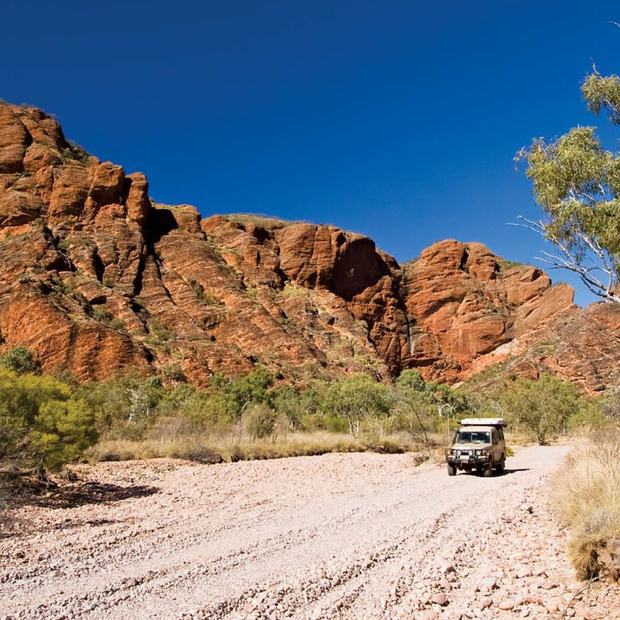The Western Australian Department of Energy, Mines, Industry Regulation and Safety (DEMIRS) regulates the mining, oil and gas industries in WA.
DEMIRS regulates access to land for resource exploration and production, and enforces compliance with environmental, health and safety standards.
The department’s Geological Survey of Western Australia (GSWA) gathers new geological and resource information across the State to gain a greater understanding of areas such as the Kimberley. GSWA field scientists interpret the geology and produce maps and information for use by industry and the community.
Resource companies produce minerals, petroleum and construction materials which are used in products that the community needs, such as metals, energy and fuel, electronics equipment (screens, batteries, motors), healthcare (artificial joints, sunscreen), construction (metals, paint, concrete), agricultural goods (fertiliser, gypsum) and a host of personal items like cosmetics and ceramics.
WA produces more than 50 different minerals and in 2022-23 had 134 principal mining projects which are high value and export-oriented. There were also 19 petroleum projects producing oil, gas and condensate from 49 fields in onshore and
offshore areas of WA.
A Snapshot of the Kimberley Resources Industry (as of March 2024)

Western Australia in 2022 - 23
- WA’s resources sector delivered record resource sales valued at $254 billion – up $20 billion on 2021–22. Iron ore remained the most significant commodity.
- Minerals made up 72 per cent of this production value. Oil, gas and condensate made up 28 per cent.
- WA’s minerals and energy exports, worth $251 billion, made up 93 per cent of all WA merchandise exports. The value of WA’s resources exports has increased by two-thirds over the past five years.
- Iron ore accounted for 68 per cent of mineral sales and 49 per cent of total mineral and petroleum sales. Spodumene concentrate (for lithium), gold, mineral sands, salt and coal all returned record sales values, as did LNG.
- In 2022–23, the WA Government received $12.76 billion in royalties from mineral and petroleum producers. Royalties are the ‘purchase price’ the State Government charges companies for the resources they extract.
- WA’s mining industry employed 126,481 operational employees in full-time equivalent terms during 2022–23. Up to three times this number are employed in service companies that support resource companies.
- At the end of 2022-23, a record number of 24,830 mining tenements covered 29 per cent of the State and around 9.3 per cent of the Kimberley.
- In 2022–23, WA accounted for 63 per cent of Australia’s total mineral exploration expenditure, worth $2.5 billion and which employed 4,195 FTE’s.
Value of resource production in the Kimberley by shire in 2022–23 was $828 million (the Pilbara was $130 billion):
- Derby-West Kimberley: $468 million.
- Halls Creek: $343 million.
- .Broome: $13 million.
- Wyndham-East Kimberley: $4 million.
Value of resource production in the Kimberley by commodity in 2022–23:
- Iron ore, cobalt and nickel: $690 million.
- Copper, gold and silver: $106 million.
- Construction materials: $17 million.
- Crude oil and dimension stone: $15 million.
Kimberley resource projects
Thunderbird mineral sands project
Halfway between Broome and Derby
– Kimberley Mineral Sands commenced ore production in October 2023. Mineral sands are used in paints and plastics,ceramics,
sunscreen, toothpaste, artificial joints and welding rods.
Ungani oilfield
Halfway between Broome and Derby
– The project is operated by Buru Energy. Commercial oil production started in July 2015, and this has been trucked to Wyndham Port. Production operations are currently suspended.
Koolan Island
Around 130km north of Derby in Yampi Sound
– Mining of high-grade iron ore was undertaken by BHP from the mid-1960s and more recently by other companies. Since 2007 it has been operated by Mt Gibson Iron.
Cockatoo Island
Around 130km north of Derby in Yampi Sound
– Cockatoo Island produced high-grade iron ore for BHP from the early 1950s and more recently by other companies. There is no active mining currently taking place.
Nicholson’s Find project on Lamboo Station
Around 40km south west of Halls Creek
– Operated by Halls Creek Mining, Nicholson’s Find produced gold, and workers commuted daily from Halls Creek. It is currently under care and maintenance.
Savannah Nickel Mine
Around 110km north of Halls Creek
– A nickel/copper/cobalt-producing mine operated by Panoramic Resources, which trucked product to Wyndham Port. It is
currently under care and maintenance.
Brown’s Range project
Around 170km south east of Halls Creek
– Northern Minerals has completed an initial three-year pilot plant project and is now assessing the feasibility of a larger commercial-scale development. The project aims to produce the heavy rare earth element dysprosium, which is used in renewable energy and high-end technology applications.
Ridges Mine
Around 110km south west of Kununurra
– The Kimberley Metals Group’s Ridges iron ore mine, which trucked ore to Wyndham for shipping, is not currently operating, with the company planning to develop the nearby Matsu deposit.
Argyle Diamond Mine
Around 120km south west of Kununurra
– Operated by Rio Tinto, the mine closed in November 2022 and is undergoing decommissioning and rehabilitation.
Exploration helps discover new mines, which will be needed to transition to a net-zero emissions future. In the Kimberley, exploration companies are seeking a range of minerals that are used in advanced technologies, as well as traditional materials such as copper, nickel, cobalt, zinc, vanadium and graphite that are also used in renewable energy applications.
Prospecting is popular in some areas of the Kimberley. Guidelines about obtaining the required authority and how to conduct prospecting can be obtained from the DEMIRS’ website. This includes safety information regarding the dangers of old mine workings and the importance of carrying a Personal Locator Beacon.
